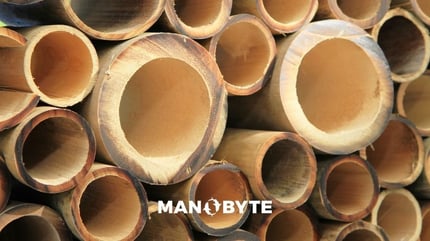Innovative Building Materials: Bamboo - A Solution to the Supply Issue?
Jillian Lambert

The push for more in the wake of lumber shortages has erupted with an array of options that have seemingly catapulted green building materials to a prominent place within the industry with even greater vigor than perhaps the shift to envisioning a more sustainable future and its associated initiatives previously evoked. As a result, many products are finding their place in the spotlight, and Bambusoideae, or its more common name, bamboo, is no exception. Credited as one of nature’s most durable, economical, versatile, fastest-growing, and safest materials, bamboo is slated to make major headway within the industry as one of the main development options for future architecture.
Bamboo’s Flaws are Few
As with all superpowers, and in this case, super materials there may be inherent weaknesses. Superman had his kryptonite, and well, bamboo has its shrinkage… Apparently, bamboo tends to shrink a tad more than wood when it loses water. It also has a high starch content, which means that if it’s not properly treated before use as a building material, it can be susceptible to fungus and insects.
Now that we’ve gotten that out of the way, let’s learn the benefits of using this incredible green building material.
What Makes It So Darn Special?
There are more than 1,200 varieties of bamboo the world over. Simply natural, raw, and infinitely unprocessed, it can last up to five years under the right conditions. Treated bamboo can last up to fifteen years. On the other hand, engineered or laminated and processed bamboo, which is typically used for producing slabs of wood, beams, and columns, can last up to 50 years.
Bamboo has a high strength to weight ratio, which is compatible with that of timber and makes it ideal for use in structures. Just when you thought that you’d heard it all….there’s, even more, to appreciate where this amazing plant is concerned. In fact, it has a higher tensile strength than steel, and its ability to endure compression is greater than that of concrete. I will explain this in greater detail a bit later. Bamboo’s rhizome-dependent biological characteristics contribute to its lightning-fast growth. It can display in 3 to 5 years the height properties Mahogany presents in 25 years. So it’s no wonder that engineers from both Cambridge and MIT have stamped this super grass with its seal of approval, recognizing it as an engineering material and viable alternative for wood for use in construction.
The properties that set it apart from the rest are:
- Tensile Strength:
- Comprehensive Strength
- Elastic Modulus
- Anisotropic Properties
Tensile Strength
Bamboo fibers run axially or in the direction of an axis. The exterior zone of the plant consists of highly flexible and elastic vascular bundles, which contribute to its capacity to withstand external stresses that tend to elongate, without fracturing or breaking.
Image adapted from ResearchGate
Comprehensive Strength
Smaller tubes of bamboo have greater compressive strength, or the ability to withstand external forces that tend to compress or reduce size without breaking, as they have a thicker outer skin. So the smaller tubes have better material composition properties and are as a result stronger.
Elastic Modulus
The elastic modulus or ability to resist deformation from the pressure of outside forces of each tube of bamboo determines the overall quality. The strength of the fibers in the outer core in conjunction with the plant’s ability to resist deformation from outside forces makes bamboo a great product for building in earthquake-prone areas.
Anisotropic Properties
Bamboo has the ability to change or assume different properties in varying directions. Its makeup in the transversal area, which is soft and brittle, differs greatly from the composition of its longitudinal fibers, which are strong and stiff.
These aforementioned properties allow bamboo to withstand hurricane-force winds. But an interesting fact about the plant that truly stands out is that its flexibility allows it to sway, absorbing the energy of the storm without giving in or breaking under the pressure. Quite an astounding characteristic--one that can be appreciated and definitely worthy of being replicated.
Food for thought...
So when considering the materials to use in your next project or new build during the current lumber shortage, take some time to get to know bamboo--it just may be exactly what you were looking for but had no idea that you needed. Happy building!
Ready to Dive In?
Work with our team of HubSpot experts and watch us take clunky systems, tech stacks, websites, and portals and turn them into tailored, intelligent workflows that deliver business outcomes.




